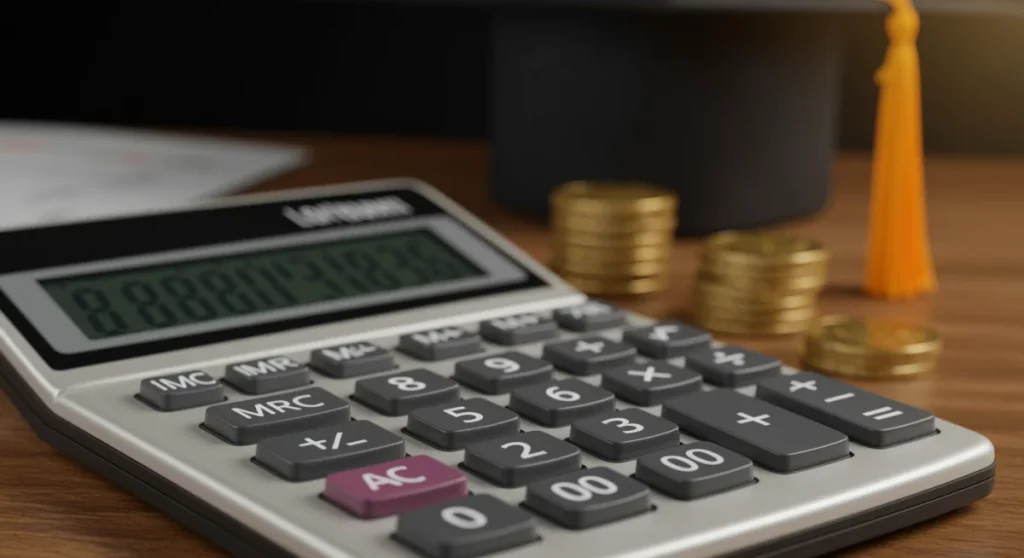Federal Student Loan Interest Rates 2025: Repayment Strategies

Understanding the latest federal student loan interest rates for 2025 is crucial for proactively developing effective repayment strategies and managing your educational debt efficiently.
As we approach 2025, many current and prospective students are keenly focused on federal student loans 2025 interest rates and how these figures will shape their financial futures. The landscape of student loan borrowing and repayment is constantly evolving, influenced by economic indicators and legislative adjustments. Staying informed about these changes is not merely a recommendation; it’s a necessity for anyone navigating the complexities of higher education finance. This article will delve into the projected interest rates, their potential impact, and the strategic approaches borrowers can adopt to manage their debt effectively.
The Mechanics of Federal Student Loan Interest Rates
Federal student loan interest rates are not set arbitrarily; they are determined by a formula established by Congress. This formula typically links rates to the yield of the 10-year Treasury note, plus an added fixed margin. This means that as the broader economic environment shifts, particularly in response to inflation and the Federal Reserve’s monetary policies, so too do the interest rates on these vital educational loans. Understanding this underlying mechanism is the first step in anticipating future changes and preparing for their effects on your repayment plan.
The rates are generally set once a year for loans disbursed between July 1st and June 30th of the following year. This annual reset provides a window of predictability for borrowers, allowing them to plan their borrowing and repayment strategies with a degree of certainty for the upcoming academic year. However, once your loan is disbursed, the interest rate is fixed for the life of that loan, providing stability amidst fluctuating economic conditions.
How Rates are Determined
- 10-Year Treasury Note Yield: This is the primary benchmark for federal student loan interest rates.
- Fixed Add-on Percentage: Congress adds a specific percentage to the Treasury yield, which varies by loan type (e.g., Direct Subsidized, Direct Unsubsidized, PLUS).
- Annual Reset: Rates are recalculated and fixed once a year for all new loans disbursed in the subsequent academic year.
For 2025, economic forecasts suggest continued vigilance from the Federal Reserve regarding inflation, which could influence Treasury yields. Borrowers should monitor these economic indicators closely, as they provide early clues about potential rate adjustments. While the exact rates for 2025 won’t be known until closer to the July 1st deadline, understanding the factors at play can help you make informed decisions.
In conclusion, the determination of federal student loan interest rates is a systematic process tied to market performance and legislative design. This structure aims to balance affordability for students with the government’s cost of lending. Staying informed about these mechanics is fundamental for anyone looking to optimize their borrowing and repayment strategies.
Projected Federal Student Loan Interest Rates for 2025
Forecasting exact interest rates for 2025 involves a degree of speculation, as they depend heavily on economic conditions leading up to July 1st. However, current trends and expert analyses offer valuable insights into what borrowers might expect. The Federal Reserve’s ongoing efforts to manage inflation, coupled with the stability of the bond market, will be key determinants. Generally, if the 10-year Treasury note yield remains stable or sees a slight increase, we could anticipate a similar trend in federal student loan rates.
Historically, federal student loan rates have remained relatively low compared to private loan options, a testament to their governmental backing. While there might be slight upward or downward movements, drastic shifts are less common. This predictability allows students and families to budget more effectively for their educational expenses.
Economic Factors Influencing 2025 Rates
- Inflation Trends: Persistent inflation can lead to higher Treasury yields, subsequently impacting loan rates.
- Federal Reserve Policy: The Fed’s interest rate decisions can indirectly influence bond yields.
- Market Demand for Bonds: High demand for Treasury notes can keep yields, and thus loan rates, lower.
Financial analysts are currently projecting a stable to modestly increasing interest rate environment for federal student loans in 2025. This means borrowers should not expect significant relief in terms of lower rates, but also perhaps not dramatic increases that would severely impact their financial planning. It’s always prudent to assume rates will be comparable to, or slightly higher than, the previous year’s rates when planning your educational funding.
In summary, while precise figures for 2025 federal student loan interest rates are yet to be announced, a careful analysis of economic indicators suggests a stable to slightly elevated rate environment. This foresight enables proactive financial planning for future borrowers.
Impact of Interest Rate Changes on Repayment Strategies
Even small changes in federal student loan interest rates can have a considerable impact on a borrower’s long-term financial commitments. A slightly higher rate means more interest accrues over the life of the loan, increasing the total amount paid. Conversely, a lower rate can free up funds for other financial goals or accelerate debt repayment. Understanding this relationship is crucial for developing an effective repayment strategy.
For borrowers with existing federal loans, the fixed interest rate means that the rates set for 2025 won’t directly change their current loan terms. However, future borrowing will be subject to these new rates. This highlights the importance of making informed decisions about each new loan taken out, as its interest rate will be locked in for the duration.
Long-Term Financial Implications
- Increased Total Cost: Higher interest rates lead to a greater overall cost of borrowing.
- Monthly Payment Adjustments: While fixed rates keep payments stable, future loans might have higher initial payments.
- Repayment Plan Choice: The impact of rates can influence the suitability of different repayment plans, such as income-driven options.
Consider a scenario where interest rates increase. A borrower might find that the standard 10-year repayment plan becomes less affordable. This could prompt a shift to an Income-Driven Repayment (IDR) plan, which adjusts monthly payments based on income and family size. While IDR plans offer flexibility, they can also extend the repayment period, potentially leading to more interest paid over time, even with a lower monthly outlay.
Ultimately, the impact of interest rate changes on repayment strategies is multifaceted. It necessitates a dynamic approach to financial planning, where borrowers regularly review their loan portfolio and adjust their strategies to align with both current rates and their personal financial situation. Proactive engagement with your loan servicer can also provide tailored advice and options.

Optimizing Your Repayment Plan for 2025
With an understanding of how interest rates are set and their potential impact, the next step is to optimize your repayment plan. This involves a careful assessment of your financial situation, understanding the various federal repayment options, and potentially exploring strategies to reduce your overall interest burden. The goal is to find a balance between affordable monthly payments and minimizing the total cost of your loan over time.
One of the most critical steps is to know your loan types and their respective interest rates. Direct Subsidized Loans typically have lower rates and do not accrue interest while you’re in school or during deferment. Direct Unsubsidized Loans and PLUS Loans usually carry slightly higher rates and accrue interest from disbursement. This distinction is vital when prioritizing which loans to pay off first, especially if you have extra funds.
Key Strategies for Optimization
- Understand All Repayment Options: Explore Standard, Graduated, Extended, and Income-Driven Repayment (IDR) plans.
- Prioritize High-Interest Loans: If you have multiple loans, focus on paying down those with the highest interest rates first.
- Make Extra Payments: Even small additional payments can significantly reduce the total interest paid and shorten your repayment period.
- Consider Refinancing (Carefully): While federal loans offer protections, private refinancing might offer lower rates if your financial situation has improved, but you lose federal benefits.
For those struggling with payments, Income-Driven Repayment (IDR) plans like PAYE, REPAYE, IBR, or ICR can be lifesavers. These plans cap your monthly payment at an affordable percentage of your discretionary income and offer loan forgiveness after 20 or 25 years of payments. However, be mindful that forgiveness may come with a tax liability on the forgiven amount.
Moreover, explore potential employer-sponsored repayment assistance programs or public service loan forgiveness (PSLF) if your career path aligns. These programs can offer substantial relief but often come with strict eligibility requirements. Proactive engagement with your loan servicer is key to understanding and implementing the best repayment strategy for your unique circumstances.
In essence, optimizing your student loan repayment plan for 2025 demands a personalized approach. By diligently evaluating your financial health and leveraging available federal programs, you can strategically navigate your debt and achieve financial stability.
Comparing Federal vs. Private Student Loans for 2025
When considering financing higher education, the choice between federal and private student loans is critical. Each type comes with distinct advantages and disadvantages, and understanding these differences is paramount, especially when looking at the interest rate environment for 2025. Federal student loans are generally the preferred first option due to their borrower-friendly terms and protections, while private loans can fill funding gaps but often come with more stringent conditions.
Federal loans offer fixed interest rates, which means your rate won’t change over the life of the loan, providing predictability in your monthly payments. They also come with a suite of benefits not typically found in private loans, such as income-driven repayment plans, deferment, forbearance, and potential loan forgiveness programs. These safety nets can be invaluable during periods of financial hardship.
Key Differences to Consider
- Interest Rates: Federal rates are fixed and often lower than private rates, though private rates can be competitive for borrowers with excellent credit.
- Repayment Options: Federal loans offer robust income-driven plans and flexible payment pauses; private loans generally do not.
- Borrower Protections: Federal loans include deferment, forbearance, and forgiveness programs; private loans have limited or no such protections.
- Credit Requirements: Federal loans typically do not require a credit check (except for PLUS loans); private loans are credit-based.
Private student loans, offered by banks, credit unions, and other financial institutions, are credit-based. This means your eligibility and interest rate depend on your credit score and financial history, or that of a co-signer. While private loans can sometimes offer lower interest rates for borrowers with exceptional credit, they often lack the flexibility and protections of federal loans. Variable interest rates are also common with private loans, meaning your monthly payments could increase if market rates rise.
For 2025, if federal rates see a slight increase, the gap between federal and private loan rates for highly creditworthy borrowers might narrow. However, the comprehensive benefits of federal loans usually outweigh a marginally lower private rate. It is always recommended to exhaust federal loan options before turning to private lenders to minimize risk and maximize flexibility.
In conclusion, the decision between federal and private student loans for 2025 should be carefully weighed, prioritizing the inherent benefits and protections of federal options before considering private alternatives, despite potential rate competitiveness.
Future Outlook and Legislative Considerations for 2025
The future of federal student loan interest rates and repayment strategies is not just influenced by economic factors but also by potential legislative changes. Congress plays a direct role in setting the formula for these rates, and any new legislation or amendments could significantly alter the landscape for borrowers in 2025 and beyond. Students and advocates continually lobby for reforms that aim to make higher education more affordable and debt more manageable.
Discussions around student loan reform often focus on simplifying repayment plans, expanding eligibility for forgiveness programs, and potentially adjusting the interest rate formula itself. While specific legislative actions for 2025 are not yet clear, the ongoing dialogue emphasizes the political will to address the growing concern of student debt in the United States. Borrowers should stay attuned to policy debates and proposed legislation, as these can introduce new opportunities or constraints.
Potential Legislative Impacts
- Interest Rate Formula Reform: Congress could adjust how interest rates are calculated, potentially lowering them or capping them.
- Expanded Forgiveness Programs: New legislation might broaden eligibility or create new paths for loan forgiveness.
- Repayment Plan Simplification: Efforts to streamline income-driven repayment plans could make them more accessible and less complex.
Furthermore, technological advancements and data analysis could lead to more personalized guidance and tools for borrowers. The Department of Education is continuously working to improve its online resources and communication channels, aiming to empower students with better information to make informed decisions about their loans. This could include more sophisticated calculators and personalized repayment advice.
The political climate and economic priorities of the incoming administration or Congress could also shape the future of student loan policy. Whether the focus remains on economic recovery, inflation control, or social programs, each has implications for how student loans are managed and how interest rates are set. Therefore, staying informed through reliable news sources and official government announcements is crucial for anticipating and adapting to future changes.
In summary, the future outlook for federal student loan interest rates and repayment strategies in 2025 is a dynamic interplay of economic forces and legislative action. Staying informed about these developments is essential for all stakeholders in the higher education finance ecosystem.
| Key Point | Brief Description |
|---|---|
| Rate Determination | Rates for 2025 federal student loans are tied to the 10-year Treasury note yield plus a fixed margin, set annually. |
| Repayment Impact | Changes in rates affect total cost and can influence the choice of repayment plans, like income-driven options. |
| Optimization Strategies | Understand repayment options, prioritize high-interest loans, and consider extra payments or refinancing. |
| Federal vs. Private | Federal loans offer more protections and fixed rates, while private loans are credit-based and lack federal benefits. |
Frequently Asked Questions About 2025 Federal Student Loan Rates
The specific federal student loan interest rates for the 2025-2026 academic year are typically announced in late May or early June, shortly before they go into effect on July 1st. These rates apply to all new loans disbursed between July 1st and June 30th of the following year.
No. Federal student loans come with fixed interest rates. Once your loan is disbursed, the interest rate is locked in for the entire life of that specific loan. The 2025 rates will only apply to new federal student loans taken out for the 2025-2026 academic year.
Federal student loan rates are primarily tied to the yield of the 10-year Treasury note. Economic factors like inflation, the Federal Reserve’s monetary policy, and the overall stability of the bond market directly impact this yield, thus influencing the final rates for 2025.
If rates increase, consider strategies like making extra payments to reduce principal faster, exploring income-driven repayment plans for lower monthly payments, or consolidating existing loans if beneficial. Always review your budget and financial goals to pick the best approach.
While specific changes are not confirmed, there is ongoing discussion in Congress about student loan reform. Potential legislative actions could include adjustments to the interest rate formula, expansion of forgiveness programs, or simplification of repayment plans. Staying informed on policy debates is advisable.
Conclusion
Navigating the complexities of federal student loan interest rates for 2025 requires diligence and a proactive approach. By understanding how these rates are determined, anticipating their potential impact, and strategically planning your repayment, borrowers can effectively manage their educational debt. The landscape of student finance is dynamic, influenced by economic trends and legislative decisions. Therefore, continuous vigilance and informed decision-making are paramount to securing your financial future and making the most of your investment in education.





